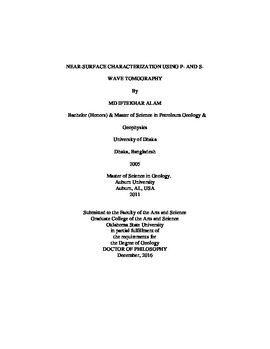| dc.contributor.advisor | Jaiswal, Priyank | |
| dc.contributor.author | Alam, M. D. Iftekhar | |
| dc.date.accessioned | 2018-03-13T18:14:45Z | |
| dc.date.available | 2018-03-13T18:14:45Z | |
| dc.date.issued | 2016-12 | |
| dc.identifier.uri | https://hdl.handle.net/11244/54470 | |
| dc.description.abstract | Near-surface seismic application, and those that mainly investigate the first 5 m of the subsurface, have to rely on analysis of transmission coda because reflections are typically lacking. Currently, full-waveform inversion, a method of iteratively refining an initial guesses of the subsurface (the starting model) so that the field data can be replicated wiggle-by-wiggle, is considered state-of-the-art in seismic modeling. However, waveform result with acoustic (or even elastic) approximation can be highly biased in the near-surface because the transmission wavefield is distorted by high porosity and patchy fluid saturation, factors that are difficult to incorporate in the forward modeling code. A less advanced method, which only attempts to replicate the first-arrival times, known as traveltime inversion, is available but not often used as a terminal analysis methods. Traveltime inversion is less susceptible to biases from porosity and saturations but has lower resolution than full-waveform methods. | |
| dc.description.abstract | This research shows that if, in addition to the typical vertical component data, tangential component data are also acquired, the first arrival times from both components together have comparable resolution to the single-component full-waveforms. This idea is demonstrated here using a 23m long profile across two well-documented utility pipes and a poorly documented backfilled void. Tangential data are acquired with horizontal phones oriented perpendicular to the profile to capture the SH propagation mode. Compressional and shear wave velocity models (VP and VS respectively) from both inversion techniques is developed. The traveltime inversion refines a simplistic 1D starting model and the full-waveform inversion refines the traveltime solution. As expected, individual traveltime images from either component are incapable of resolving the targets, but the full-waveform images are. However, when VP and VS traveltime images are combined as a Poisson's Ratio image, targets resolution is comparable to the full-waveform inversion results. | |
| dc.description.abstract | Results for this thesis allow a practitioner to optimize resources for near-surface seismic survey. Multi-component acquisition is more difficult and expensive than a single-component survey; but multi-component traveltime processing is easier to implement than the single-component full-waveform inversion. The results may appear to question the utility of full-waveform in near surface characterization, however, full-waveforms also yield the attenuation solution, which cannot be obtained from the arrival times and is very helpful in near-surface characterization. Although the results are presented using an ultra-shallow example, they are applicable to a wider range of settings such as shear and rupture zones or even in medical imaging where all physical factors that distort waveforms cannot be incorporated in modeling. | |
| dc.format | application/pdf | |
| dc.language | en_US | |
| dc.rights | Copyright is held by the author who has granted the Oklahoma State University Library the non-exclusive right to share this material in its institutional repository. Contact Digital Library Services at lib-dls@okstate.edu or 405-744-9161 for the permission policy on the use, reproduction or distribution of this material. | |
| dc.title | Near-surface characterization using P- and S-wave tomography | |
| dc.contributor.committeeMember | Atekwana, Estella A. | |
| dc.contributor.committeeMember | Halihan, Todd | |
| dc.contributor.committeeMember | Wang, Yanqiu | |
| osu.filename | ALAM_okstate_0664D_14942.pdf | |
| osu.accesstype | Open Access | |
| dc.type.genre | Dissertation | |
| dc.type.material | Text | |
| thesis.degree.discipline | Geology | |
| thesis.degree.grantor | Oklahoma State University | |
